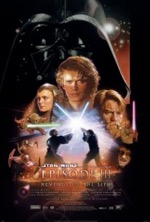Star Wars: Episode III—Revenge of the Sith (PG-13)

Starring: Ewan McGregor
May 2005
“Lucas Signs Off With a Vengeance”
“The circle is now complete. When you left I was but a learner. Now, I am the master.” Darth Vader’s formerly cryptic words in Star Wars: Episode IV—A New Hope now find clarity and resonance in light of the dark, tragic and force-shifting events that occur in George Lucas’ latest and last Star Wars film: Episode III—Revenge of the Sith.
For about the first fifteen minutes of the film, I thought I was in for the same pedestrian plot overshadowed by whiz-bang effects like in the last two episodes—a massive battle rages over city-planet, Coruscant, and Obi-Wan Kenobi (Ewan McGregor) and Anakin Skywalker (Hayden Christensen) dodge exploding vessels and fend off an onslaught of vulture and buzz droids—but when the Jedi warriors tag-team nefarious Count Dooku (Christopher Lee) under the watchful and gleeful gaze of Chancellor Palpatine (Ian McDiarmid), I saw the potential for the kind grand storytelling last seen in the original trilogy. The lightsaber battle is eerily similar to the one featured at the climax of Return of the Jedi, only this time, Palpatine/Sidious knows he has his man in the tortured, hate-infused dynamo, Anakin Skywalker, who beheads Dooku at Sidious’ request…unwittingly opening a position on the Sith roster which he will rapidly fill.
Rapid is a word that aptly describes Episode III, both in Anakin’s accelerated descent into the Dark Side of the force and in the film’s hyper-speed pacing. Much of the movie is typical Star Wars camp—especially the ever-leaden dialogue and passionless love scenes—but Episode III boasts several show-stopping action sequences and dramatic crescendos, including: Mace Windu (Samuel L. Jackson) and company arriving to arrest Palpatine, Anakin’s fateful choice to follow Sidious, Anakin’s cleansing of the Jedi temple, Yoda and Sidious engaging in a wizard’s duel and, of course, the final, epic showdown between teacher and pupil—a haunting scene that’s been common knowledge in fan circles since the late seventies. Add to that the gut-wrenching montage of clone troops turning on their Jedi leaders and you have a visually stunning, powerfully moving film.
What’s refreshing about Episode III is that it’s the first prequel to properly balance story and special effects. It’s been rumored that Lucas had more focus and passion this time around and you can see that renewed enthusiasm for his oft-neglected brainchild translated onto the screen. The visionary auteur has also waved his Jedi fingers to evoke a wider range of emotions from his actors this outing, except for Natalie Portman, whose lack of story involvement seems to have cued her uninspired performance. Hayden Christensen’s acting has vastly improved from his “Obi-Wan is holding me back” days; he delivers a believable, multi-layered performance that lends credibility to Anakin’s seemingly sudden transformation into Darth Vader.
Episode III’s spotlight is squarely fixed upon Christensen’s character, but the movie would have found itself charbroiled in a lava pit without stellar support from the two Mc’s. McGregor’s turn as the older, wiser Obi-Wan anchors the movie in much the same manner that Liam Neeson’s Qui-Gon Jinn did in Episode I—there’s a new level of maturity and weight to Obi-Wan and his scrappy fighting style lends personality to the movie’s static and prolific lightsaber confrontations. McGregor’s impassioned, “you were supposed to be the chosen one” monologue contains finer dialogue and more unbridled, visceral emotion than the rest of the prequel trilogy combined—it’s THE moment of the entire Star Wars myth. McDiarmid is absolutely delicious as the insidious Darth Sidious (Lucas and his names!); he’s so good at presenting the virtues of the Dark Side that he makes Anakin’s swift conversion plausible. The Scottish thespian’s sinister basso profundo is one of the best effects in the film—Sidious’ hypnotic timbre in tandem with convincing stories, like the chilling tale of Darth Pleagus, draws Anakin into his web of deception and is the solitary reason why the audience buys into Anakin’s accelerated transfiguration.
Lucas enlisted the help of his good friend, Steven Spielberg, on some of the movie’s most heart-pounding action sequences, and you can tell—no more silly pod races or droid factory chases created with an eye on the arcade. The special effects are crisper than ever (except for the constipated clone troopers), and in some cases are too refined…R2-D2 seems to undergo a series of upgrades for each new film, begging the question, “Why couldn’t he do that before?”
Pundits have said that if you’re consciously aware of the score when watching a movie, the composer has failed in his/her role of servicing, not dominating, the narrative. I never thought I’d ever write these words, but John Williams’ derivative sound track for Episode III severely disappointed me—besides recycling material from nearly every other Star Wars film, he also regurgitated the main title from The Lost World (1997) for the attack on the Wookie homeworld. The greatest living motion picture composer should have delivered a more “original” score for his final trip to a galaxy far, far away.
Episode III approaches epic status and has effectively returned the films to their space opera roots. This is arguably the best episode since the original Star Wars and is a gratifying and satisfying conclusion to Lucas’ sprawling space saga—he’s tidied up all the loose ends and signed off in grand fashion. When Obi-Wan delivers infant Luke to Aunt Beru on Tatooine in the final scene—the desert planet’s twin suns poised to dip behind the painted horizon in a familiar tableau—it doesn’t take a Sith sense to know that Star Wars has come full circle.
Rating: 3 1/2